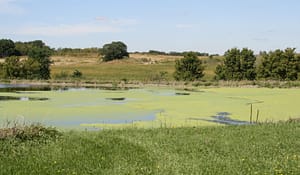
Insufficient DO causes all sorts of problems, from lagoon odors to permit violations. In this article, we’ll talk about lagoon dissolved oxygen: where it comes from, how levels change over the course of a day, potential causes of low DO, and how to ensure your wastewater lagoon system always has sufficient DO to stay in compliance.
What is lagoon dissolved oxygen?
Lagoon DO feeds the microbial lifeforms that aerobically treat wastewater BOD. Sufficient lagoon DO controls odors, assists in nitrification, and optimizes BOD removal. Without it, the bacterial microorganisms will begin to break down the waste without oxygen, or anaerobically—a slow and malodorous process.
In a facultative lagoon, oxygen is supplied by the interface between the lagoon surface and the atmosphere. Another source of oxygen is algae, which act like little aerators during the day. On a normal sunny afternoon, algae can produce about 1.6 lbs. of oxygen, saturating surface layers up to 40 mg/L. At night, however, they respire or use up oxygen, resulting in variant DO concentrations over the course of the day, with the highest during the afternoon and the lowest at night.
While having algae provide “free” oxygen to a lagoon sounds great, excess algae create BOD and total suspended solids (TSS) problems, form smelly mats that block sunlight, and some types, namely blue-green algae or cyanobacteria, can even release dangerous toxins. Algae also uptake the nutrients nitrogen and phosphorus, which they re-release back into the water column as they die.

A facultative lagoon will also have different DO levels at different depths, with higher levels at the surface due to algae and wind influence, and lower levels near the bottom, where sludge will accumulate.
What are the signs of low lagoon dissolved oxygen?
Of course, high BOD and TSS levels in the effluent demonstrate low lagoon dissolved oxygen conditions, but there are also some sensory clues.
1. Color: The color of a lagoon offers useful information about treatment conditions. Any color except for sparkling blue, green, or brown water is a clue that DO may be too low.
Pea soup green or green streaks: Too much algae
Bright green and leafy: Duckweed
Clear: Possibly ammonia or sulfide toxicity
Red: Purple sulfur bacteria, which like low oxygen conditions
Red patches: Daphnia are stressed by lack of oxygen
Gray or black: Septic
Our blog, What color is your wastewater lagoon?, covers this subject in detail.
2. Odor: A wastewater lagoon with sufficient DO should not be producing objectionable odors. Strong grassy, fishy, sulfurous, or sewage odors indicate a problem.

Possible causes of low lagoon dissolved oxygen
Wastewater Lagoon Troubleshooting, An Operators Guide by lagoon expert Steve Harris outlines some possible causes of low lagoon DO:
- Not enough sunlight due to cloudy conditions or surface coverage by ice, duckweed, algae mats, sludge, or turbidity
- Not enough wind, due to blockage by trees or shrubs
- Excess BOD loading
- Toxicity from ammonia, hydrogen sulfide, chlorine, metals, or herbicides
- Too much sludge
- Insufficient or under-performing aeration equipment
- Wrong size or number of aerators
- Improperly placed aeration units
- Short circuiting
How to correct low lagoon dissolved oxygen
There are several ways to improve DO in a wastewater lagoon, primarily by correcting the cause of the low DO conditions.
- Remove the duckweed, matted algae, or sludge that is blocking the surface
- Cut down any trees or plant materials that are interfering with the wind action on the lagoon
- Reduce BOD loading by adding an influent screen, or run lagoons in parallel instead of in series
- Reduce influent toxicity by taking affected lagoon offline
- Remove sludge
- Improve aeration and mixing
Optimal aeration prevents low lagoon dissolved oxygen
A properly aerated and mixed lagoon will have dissolved oxygen levels that are always sufficient for the influent BOD and consistent over the course of the day and throughout the water column. There will be virtually no algae and solids will be kept in suspension where they can digest instead of settling as sludge.
Triplepoint’s Ares Aerator® provides lagoon aeration and mixing in a single unit. Efficient fine bubble aeration, with its high surface area bubbles, maximizes dissolved oxygen levels and biological treatment. The coarse bubbles emitted from the static tube provide robust mixing and churning action, promoting oxygen transfer and preventing algae and sludge buildup.
The Ares Lagoon Aeration System is designed to mix the entire water column to help maximize oxygen transfer and ensure your system is compliant—for more information, download our Ares brochure.

